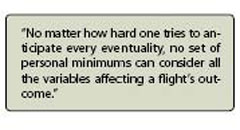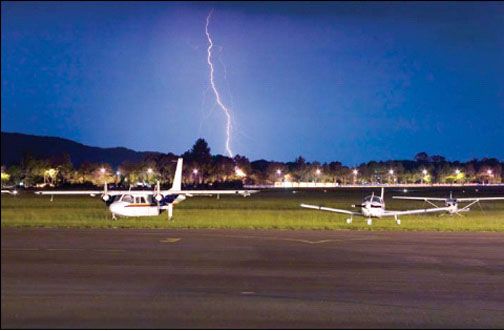If youve been around aviation much at all, youve heard this one before: “[Fill in the blank] is a license to learn.” The speaker invariably is looking in the direction of a freshly minted Private pilot or someone with a wet-ink Instrument rating. He or she is admonishing, in a not-so-subtle way, that a certificate of accomplishment issued by the FAA doesnt mean squat on a dark and stormy night when the rain sounds like a bad rock bands drummer and the altimeter just wont stay in one place. 400 The fact is, theyre right: That piece of paper or laminated plastic you carry means you could fly an aircraft to someones satisfaction on a given day sometime in the past; it doesnt mean you-or your airplane-are ready to safely fly in the weather between you and your destination. So, how can an inexperienced pilot set his or her own standards to determine what is and is not a safe operation? Should these so-called “personal minimums” be formalized, or are they a day-to-day thing? Should you even have personal minimums? What good are they? Lets look. Yes or no?

When I got my Instrument rating, back in the days when things like GPS, moving maps and even Loran mostly were the stuff of science fiction (yes, we did have ILS and, yes, Skyhawks had swept tails by then, thank you very much), my double-II and I did everything we could to ensure I had the tools necessary to go out and shoot in-weather approaches to the published minimums on Day One. Our work included as much “real-world” IFR as our competing schedules and my budget could afford. Thats the only way to do instrument training and, if your double-II shies away from giving dual in IMC, I strongly suggest you find someone who will.
All of which brings me to this not-so-bold statement: There are two major problems with personal minimums. The first is that, no matter how hard one tries to anticipate every eventuality, no set of personal minimums can consider all the variables affecting a flights outcome.
The second problem is a bit more complicated but basically comes down to this: If a pilot has enough self-discipline to adhere to a set of standards he or she developed, then he or she probably has enough on the ball to avoid getting into trouble in the first place.
In other words, the people who develop and adhere to personal minimums are the people who dont need them. The corollary, of course, is that no number of personal minimums will prevent someone from getting into trouble if the standards arent implemented.
Hows that for what I retained from Psychology 101?
So, while it might be hopeless to develop our own set of personal minimums, it would be irresponsible to ignore the fact that some weather easily can exceed our capabilities. The reasons can include lack of experience, a poorly equipped airplane, fatigue, external pressures, something as simple as the time of day or all of the above.
Metrics
One morning several years ago, I was scheduled to give a presentation in a city some 500 air miles away. I had planned to go down the night before, make my spiel, and fly home that afternoon. In checking the weather for the night flight, I discovered the Carolinas were thoroughly peppered with Level 4 and 5 thunderstorms. I could have gone around them to the west, but that would have made for a much longer flight featuring a later arrival and some two or more hours of night flying over mountainous terrain.
Since my favorite and time-tested method for staying out of thunderstorms involves staying in daytime VMC so I can see and avoid them, which really hard to do at night, I bagged the flight.
Instead, I got up at oh-dark-thirty, long after the storms had died out, and launched for my destination well before dawn. I was in and out of rain and stratus most of the way, but it was a smooth ride. I had the best seat on the east coast for that days sunrise and was the first to use the ILS at my destination that morning.
In this instance, my change in plans
could be attributed to personal minimums-I prefer to think of it as a healthy respect for thunderstorms-but there are few metrics to apply when looking at Nexrad displays resembling the pizza you had for dinner last night.Supposedly, thats one of the underlying reasons the FAAs own guidance materials on personal minimums dont concentrate on things like ceilings or visibilities. Instead, as the sidebar on page 5 highlights, the FAAs system depends on some honest, soul-searching self-assessments as well as honest evaluations of the weather and the aircraft.
So, presuming we want to develop some kind of formal pre-flight evaluation system, what should it look like? One way to tackle the topic is to break down a flight into its basic components, like the departure, the en route portion and the arrival.
Departures
For instrument operations, though, I need to think about two things: Can I get back into this airport in a hurry if I need to and, if not, whats my Plan B?
My decision to depart in IMC comes after considering the ceiling and visibility, the traffic situation, available approaches and nearby airports. If I have a problem after entering IMC, Ill likely have to perform a full approach procedure to get back in. While its legal for a Part 91 operator to depart in conditions as bad as zero-zero-and Ive done it-the occasional need to get back on the ground in a hurry doesnt make it the wisest choice. In this situation, you are assured of needing a different nearby airport with an approach to get back on the ground. That airport may be socked in, also, or getting there may involve more effort than you want to exert. Unless youve confirmed its availability by checking Notams, the approach you want may not even be an option.
My pucker factor involving an instrument takeoff becomes greatest when the weather is at or below approach minimums and there isnt an ILS nearby. On one hand, this means Ill have very little time to verify the airplane is performing as expected before entering the clag. A little more “cushion,” afforded by a higher ceiling, for example, makes the decision easier. Too, a low ceiling means Ill probably need to perform the full procedure-while dealing with an emergency-and theres no guarantee Ill be successful.
En route
My first “for-real” IFR flight, right after I earned the rating, involved a dark and stormy night over the mountains of western North Carolina. The poor little Skyhawk I was flogging didnt have the legs to reach Asheville, N.C., without more gas, so a stop and hop in Hickory became necessary. Mine was the only airplane moving that night, and the “night, IFR, single-engine, mountains” aspect of the flight drew a concerned remark from the FBO crew.
Its one thing to depart in good VMC, spend a lot of your en route time in IMC and arrive in good VMC. Its another to spend the entire flight in IMC. In addition to fatigue, theres the issue of where to go and what to do if “a problem”
crops up. Cruising on top or in IMC when the airports below you are all reporting good VFR allows a healthy safety margin but, when the entire area is down the tubes, one needs to think about things a bit more.
For example, where would you find some decent VFR for a letdown and landing if the airplanes electrical system went on vacation? If its night, over the mountains, well…be sure to call me when you land.
The point is that we need to think about how bad the en route conditions need to be before we consider canceling or diverting. Simply stating everything has to be at least 2500 overcast and five miles wont cut it. Again, its a complicated calculus, involving fuel, weather, fatigue and the airplanes capabilities, among other factors.
Arrivals
One really easy example comes to mind. A couple of years ago, I flogged my poor little Debonair from Scottsdale, Ariz., back to my home plate of Manassas, Va., in one day. Less than 10 hours of solo flying, to be exact, which included a fuel stop near Oklahoma City. Yes, I had a pretty decent tailwind most of the day, a rarity for me.
The weather along the way was good, and there were no issues getting home. But thats a long day, and I was understandably tired at the end of it. If there had been any significant weather at my destination, I would have thought long and hard about pulling up short and spending the night. Doing so probably would have allowed any bad stuff to blow out, but certainly would have resulted in a more rested pilot and full tanks.
In this instance, if there had been some weather forcing an approach, Im not sure what I would have done. On one hand, I know the ILS to home plate extremely well and am comfortable hand-flying it down to minimums in some pretty raunchy weather. On the other hand, I would not have been fresh and any “curves” thrown at me by an equipment issue, changing weather or ATC might have meant a meandering track down the final approach course. But the weather held, the airplane hummed and even ATC was relatively benign.
At the same time, there were plenty of alternatives available, not least of which had to do with being able to carry plenty of gas. There were numerous airports along the way and near my destination. But the bottom line was that the weather was good and, at least for most of the flight, I was fresh and rested.
To me, those are the real “personal minimums”: the overall weather picture, the airplanes condition, how rested I am and how familiar I am with the destination airport and its environment. I wouldnt have made that flight in the opposite direction since Im not as familiar with the destination. Unless I had an extremely rare wind out of the east, it wouldnt have happened, anyway. Setting your personal minimums to some arbitrary numbers shouldnt be the only things factored into the go/no-go decision.




